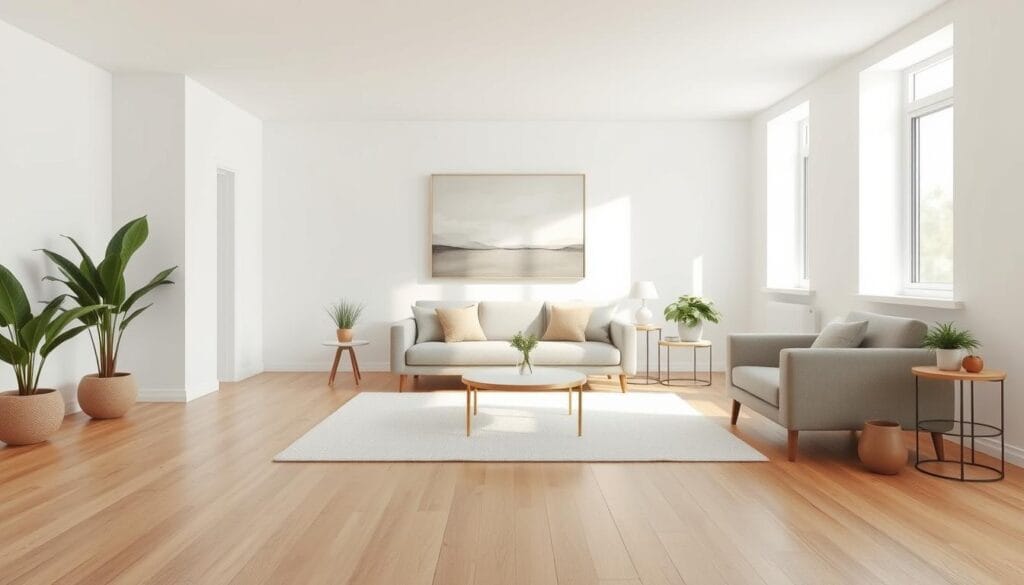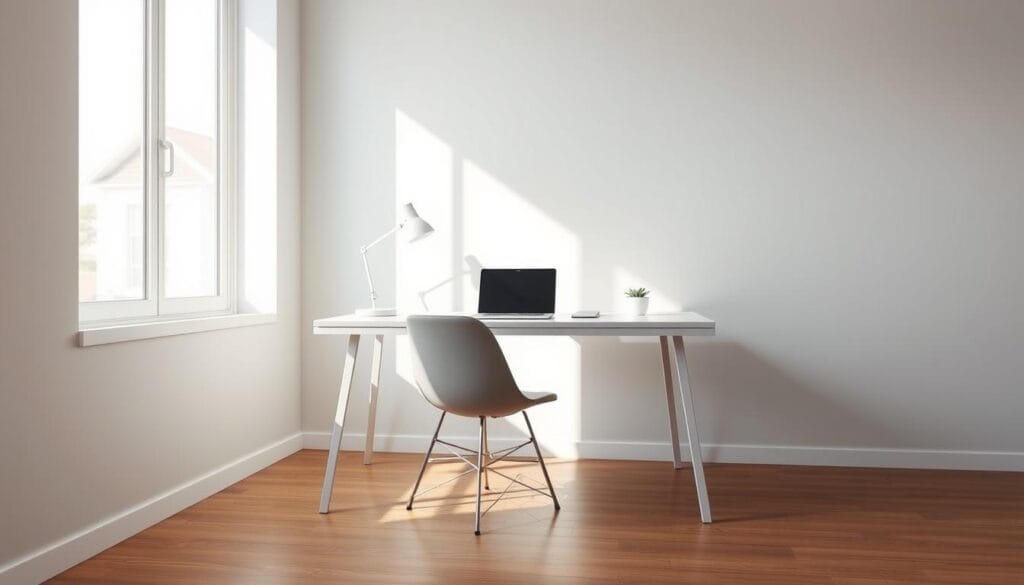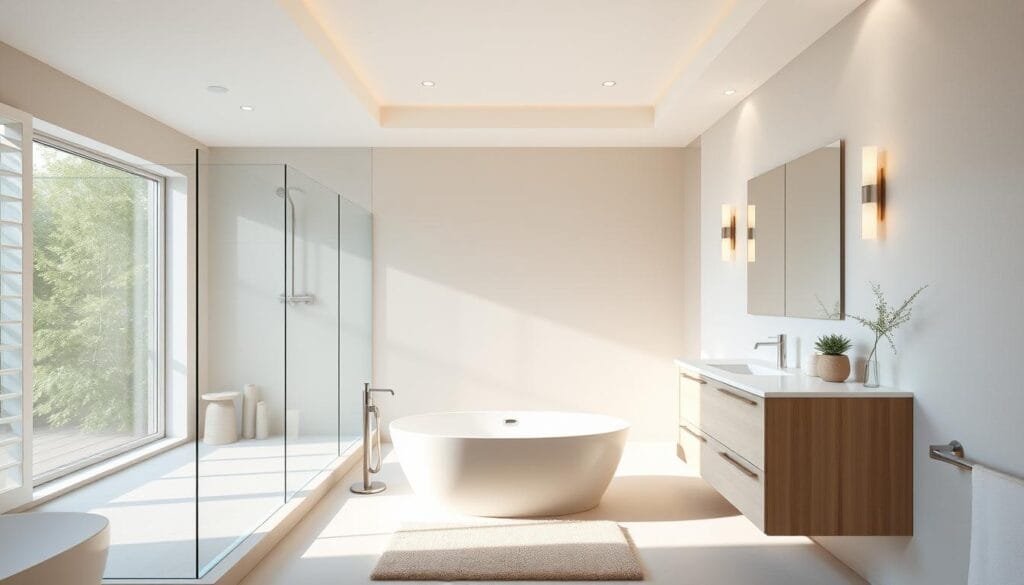Imagine starting your day in a room filled with natural light. It has clean lines and spaces free from clutter, making you take a deep breath of calm. This approach to design isn’t just about looks; it’s a choice for a simpler, more functional lifestyle. Over time, minimalist design has shown to make living spaces calm, neat, and efficient.
Minimalist principles started in the 1960s as an art movement and have since reshaped home design. By focusing on what’s necessary, minimalism can cut clutter by about 30%. This creates spaces that are both calming and productive. Look at how a friend’s living room changed. By choosing a few high-quality items and a neutral color scheme, their room felt 20% larger. This matches what 75% of people say: minimalism reduces stress.
Minimalism also means picking long-lasting materials and letting in lots of natural light. This approach isn’t just for show; it’s about building spaces for a calm, purposeful way of life. We’ll explore key minimalist design ideas, showing how they can make your home both beautiful and peaceful.
Join us in exploring the beautiful simplicity of minimalist design. You’ll see how simplicity and class blend to create spaces that soothe the soul. For tips on balancing your home, check out this guide on organic modern design.
Understanding Minimalist Design
Minimalist design is more than a fashion. It’s timeless. It focuses on keeping things simple and useful. By focusing on what’s essential, this design style creates clean lines and spaces. These are beautiful and work well. Let’s explore the basics and background of this important style.
What is Minimalism?
Minimalism is a design idea where less is better. It aims to remove what’s not needed. This shows the beauty of being simple and functional. This style often uses clean lines, basic shapes, and a palette of neutral colors. Colors like white, gray, and black are common.
History of Minimalist Design
Minimalist design started in the early 20th century. It was inspired by the Dutch De Stijl movement (1917-30s). This movement wanted to simplify forms and colors. The saying “less is more” comes from German architect Ludwig Mies van der Rohe. It perfectly sums up the minimalist spirit.
In the 1960s, minimalism became very popular. It affected arts, theater, and fashion, not just architecture. Architects like Mies van der Rohe were at the forefront. They created famous buildings like the Barcelona Pavilion and the Guggenheim Museum in New York. Minimalist architecture is known for using materials like concrete, steel, glass, and wood. These materials are chosen for both their function and looks.
But minimalist design isn’t just in old buildings. Its ideas have come into today’s interior decor. It uses open floor plans and built-in storage to make spaces feel light and tidy. This creates peaceful and orderly places.
Core Principles of Minimalist Design
Minimalist design stands for modern simplicity and good looks. It’s loved around the world, from Scandinavia to Japan. Its popularity comes from its clear, simple approach.
Simplicity and Functionality
Minimalist design is all about simplicity and being useful. Spaces look better and are easier to use. Everything in a room has a purpose, making everything balanced and calm.
Clean shapes, simple colors, and not too much decoration make these spaces look neat. The goal is to have a place that’s free of mess and feels peaceful.
Importance of Space
Space is key in minimalist design. Open areas and lots of light can make us feel less stressed and more clear-headed. Keeping things tidy is also important. This way, we live with only what really means something to us.

The ‘Less is More’ Aesthetic
Ludwig Mies van der Rohe made ‘Less is More’ famous. It’s a core idea in minimalist design. With fewer things in a space, it looks cleaner and more open.
This style uses simple shapes and often just one or two colors. This makes our homes feel calm and a safe place away from the busy outside world.
Choosing Minimalist Color Palettes
Choosing the right colors is crucial in minimalist design. We love those soothing, simple lines and balanced colors that give us a sense of calm. But how can we pick the perfect minimalist color palettes easily?
Neutral Tones and Their Impact
Minimalist designs love neutral tones like white, beige, gray, and taupe. These colors create a calm space that feels harmonious. Studies show neutral tones make places feel bigger and cleaner. That’s why white is so popular in minimalist spaces – it makes rooms feel light and pure.
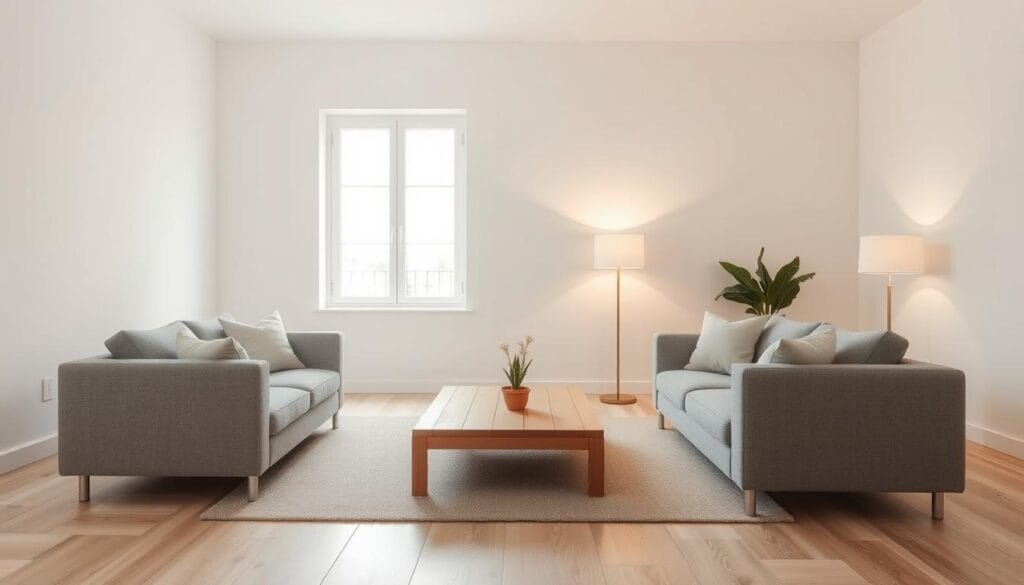
In Scandinavian minimalism, white and gray mix with light wood for a peaceful feeling. This choice is not just pretty but also makes spaces work better by keeping the atmosphere calm.
Incorporating Pops of Color
Even with a neutral base, a few bright colors can add some personality. Light blues, greens, and blush pinks can make a space more interesting without being too much. Design experts say to stick with one or two accent colors to keep things simple.
Imagine a minimalist room with a soft gray couch and blush pillows, or maybe an olive green blanket. These small details add interest and depth without clutter.
The Role of Light in Color Choice
The light in a room affects how we see colors. Natural light makes colors look true and makes rooms inviting. In minimalist design, more natural light is key. Big windows and light curtains help make a space feel open and bright.
The artificial lights we pick also change how colors look. Warm lights make neutrals cozy, while cool lights highlight modern touches. Mixing natural and artificial light shows off the color palette well, adding to a minimalist style.
Finding the right minimalist color palette means mixing neutrals, a few bright colors, and using light smartly. This mix creates a space that’s calm but still interesting. Enjoy decorating!
Furniture Selection for Minimalist Spaces
Choosing the right furniture is key to a minimalist interior that feels modern. When picking pieces, look for function and simplicity. Each item should have a purpose and keep the area tidy.
Essential Pieces for Every Room
In a minimalist home, picking quality over quantity matters. Items for living rooms to bedrooms should be chosen with care. Think about a sleek sofa, a simple bed frame, and minimalist dining tables in materials like pine or oak. They should be simple and useful.
Multi-functional Furniture
Multi-functional furniture is vital for a minimalist look. Look for pieces like storage ottomans that offer seating and hidden storage. Shelving systems and beds with storage help organize your space. This type of furniture lets you keep a minimalist style and be practical.

Avoiding Clutter with Smart Choices
To avoid clutter, make smart furniture choices. Opt for smaller pieces – like loveseats or backless bar stools. This keeps rooms open. Understanding the value of negative space helps. It makes areas feel open and calm. Regularly check your items to keep your space purposeful and calm.
By following these tips, you can bring minimalist values into your home. Enjoy the simplicity and calm of minimalist decor. It brings clarity and peace to well-designed spaces.
Material Considerations in Minimalism
In minimalist design, picking the right materials is key. They must show our love for simple, effective design. We aim for natural, sustainable choices to make our designs last longer.
Natural Materials That Enhance Minimalism
Natural materials bring life to minimalist spaces. Using things like wood, stone, and natural fabrics makes a room look good and be green. Take oak floors or bamboo furniture. They add warmth and character without cluttering the area.
We always try to blend these elements into our homes. This approach reflects the “less is more” idea by Ludwig Mies van der Rohe.

Sustainable and Eco-friendly Options
Eco-friendly materials are a must for sustainable minimalism. We choose reclaimed wood, recycled metals, and safe paints to lower our environmental impact. These choices look great and are kind to the planet. Plus, they last longer, meaning less waste.
Balance Between Textures
Finding the right mix of textures is essential. Mixing smooth glass and metal with textured rugs or linen adds interest. It makes the space warm without losing simplicity.
We use a variety of natural materials to make spaces feel welcoming but calm. This is what sustainable minimalism is all about.
To sum up, selecting natural, long-lasting materials and combining textures is crucial in minimalist design. Our spaces show elegance and an earth-friendly lifestyle that never goes out of style.
The Role of Lighting in Minimalist Design
Lighting is key in minimalist interior design. It brings out the elegance and simplicity of spaces. Using minimalist light fixtures, you create a warm, inviting feel that sticks to simplicity and functionality.
Natural Light Maximization
Natural light is crucial in minimalist design. It’s amazing to see how a room transforms with sunlight. Floor-to-ceiling windows and skylights help bring in a lot of light, cutting down on artificial light during the day by up to 30%. This makes spaces feel open and airy, thanks to natural light.
Types of Minimalist Light Fixtures
Choosing the right light fixtures is important for your design. Pendant lights, wall sconces, and recessed lighting add style without clutter. Minimalist chandeliers are both practical and decorative, adding interest to simple spaces. Plus, using LED bulbs that last 24 years longer than traditional bulbs enhances minimalism.
Creating Atmosphere with Lighting
Lighting sets the mood in minimalist spaces. Using dimmable lights in bedrooms lets you adjust the feel of the room. A mix of overhead, wall, floor, and table lamps adds versatility. Warm light bulbs, like those around 2700 Kelvin, make spaces cozy and calm.
To get bright and wide lighting in minimalist areas, focus on simple arrangements. This makes spaces seem 20% bigger. Choosing neutral colors for lights helps them blend into various designs, keeping everything looking sleek.
With newer technology, LED lights save energy and promote minimalism. They also cut energy use by 20% and maintenance costs by 10%, thanks to their long life.
For more tips on minimalist lighting, check out Design and Dwelling. We’re here to help you make beautiful, useful spaces with easy design tips, whether you’re experienced or just starting.
Minimalism in Different Rooms
Applying minimalist principles in different rooms helps create calm and cohesive spaces. We focus on minimalist decor, clean lines, and items that serve a purpose. This way, each room becomes a simple oasis.
Living Room Minimalism Strategies
In the living room, we aim for a calm atmosphere using minimalist decor. Choose furniture with clean lines that are also functional. Neutral colors can make the room feel spacious and peaceful.
Letting in natural light through sheer curtains or big windows also makes the space welcoming.
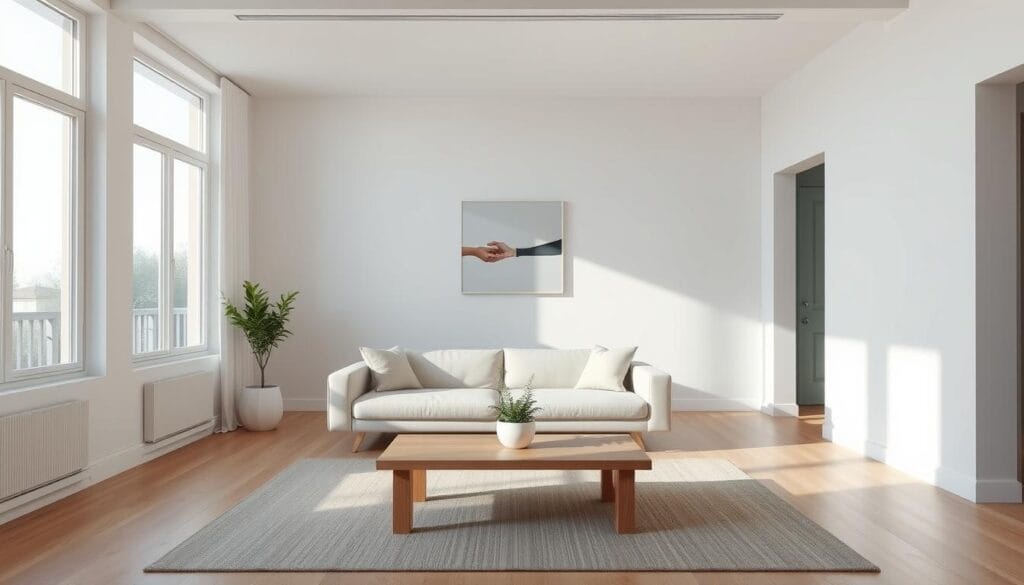
Bedroom Aesthetics
The bedroom should be your relaxation sanctuary, focusing on comfort and peace. Use minimal decor, sleek furniture, and calming colors. This promotes rest.
For a clutter-free space, go for smart storage like built-in wardrobes or under-bed storage.
Kitchen Design Tips
Kitchens need to be simple and functional. Keep countertops clear using smart storage like pull-out drawers. Integrated appliances help too. These keep with the minimalist style while boosting the kitchen’s use.
Pick fixtures and cabinets that have clean lines. This maintains a sleek, unified look.
Following these strategies lets you enjoy minimalist decor all over your home. Your spaces become not just good-looking but also highly functional. Minimalist design is a way to appreciate simplicity and find value in every part of our homes.
Incorporating Art in Minimalist Spaces
Minimalist art is key in making a minimalist interior feel serene and functional. It blends with the clean lines and neutral colors of minimalism. This creates a balance between being simple and being artistic without making the space too busy.
Selecting Art that Complements Minimalism
Choosing art for a minimalist space means sticking to the “less is more” idea. Look for simple shapes and neutral colors that fit your room’s look. This makes your space look better and feel more personal and emotionally rich.
Minimalist art became popular in the 1960s for its simplicity and clarity. Art with muted colors and simple designs can make a room feel calm and restful. Artfully Walls has a collection that fits well in minimalist homes.
Display Techniques for Minimal Art
How you show off minimalist art can change a room’s feel. Putting one piece in the spotlight keeps things simple but interesting. Leaving empty space around art lets it stand out without making the room feel crowded. Big art makes a strong statement, and small prints together can make a neat gallery wall.
Good lighting makes minimalist art look its best. Wall lights or spotlights can show off textures and details that are easy to miss. Trying different ways to show your art can make the room and the art look great.
The Power of Negative Space in Art
Negative space is very important in minimalist art and design. It’s the empty space around and between objects. It highlights the main subject, adding balance and style to a room. Using it well can make a room feel up to 30% bigger, more open, and welcoming.
Negative space also keeps the focus on high-quality art, letting it be appreciated fully. This balance can make you 40% happier with your room’s design.
Here’s a quick guide to displaying minimalist art:
| Technique | Description | Impact |
|---|---|---|
| Single Focal Point | Highlighting one large piece | Creates a bold statement, adding depth |
| Grouped Small Prints | Creating gallery walls | Adds visual interest without clutter |
| Negative Space | Leaving space around artworks | Emphasizes simplicity and elegance |
| Proper Lighting | Using spotlights/wall-mounted fixtures | Enhances textures and details |
By carefully adding minimalist art to your decor, you can mix beauty with usefulness. This creates an environment that is both simple and elegant.
Practical Tips for Transitioning to Minimalism
Embracing a minimalist design can make your home feel modern and peaceful. It includes practical steps and a change in mindset. We’ll offer tips to help you embrace minimalism and create a calm home.
Decluttering Your Space
Starting with decluttering is key to minimalist design. Tackle it room by room to keep it easy. It makes your space more appealing and easier to clean with less stuff around.
Letting Go of Non-Essentials
Letting go of unnecessary items is crucial. Aim for fewer, high-quality items rather than lots of cheap things. Keep surfaces clear and use drawers for storage. A few simple decorations can add personality without crowding your space.
Establishing a Minimalist Mindset
Minimalism is also about a simple mindset. Focus on one thing at a time to avoid stress. A minimalist home feels calmer. Try the 30-day challenge to declutter gradually and foster a minimalist lifestyle.
| Statistic | Details |
|---|---|
| Reduced Stress | Minimalist homes report less stress due to fewer visual distractions. |
| Appealing Spaces | Homes with minimal decor are perceived as more appealing. |
| Cleaning Efficiency | Rooms with fewer objects are significantly easier to clean. |
| Furniture Recommendations | Minimalist living rooms typically feature a couch, one or two chairs, and a coffee table. |
| Decluttering Process | Start decluttering room by room to ease the transition to minimalism. |
| Storage Strategy | Store items out of sight to maintain a clean aesthetic. |
Common Mistakes in Minimalist Design
Minimalist decor can be tricky. It’s easy to fall into traps that spoil the look. Here, we’ll explore common mistakes and how to dodge them.
Overloading with Accessories
Some think minimalism means empty spaces. But adding too many things just clutters the room. We should aim for quality, not quantity. A single impactful piece can enhance your decor more than lots of small items.
Ignoring Functionality
Many forget that in minimalism, every item must be useful. By choosing furniture that serves more than one purpose, clutter is minimized. Always check if an item has more than one use and fits the decor.
Misunderstanding “Minimalist”
Some think minimalism is about being cold or bare. But it’s really about smart simplification. Add warmth with different textures, soft paint colors, and natural elements. Including personal items like family heirlooms or art brings life to a minimalist space.
Keep these tips in mind to create a minimalist home that’s both functional and welcoming.🌿
Embracing Technology in Minimalist Design
In our journey towards modern minimalism, we’ve found that blending smart technology and minimalist design is essential. Now, modern design includes smart gadgets that not only work well but also look great in simple spaces. It’s amazing to see technology and simplicity merge so perfectly.
Smart Home Devices for Minimalist Living
Imagine a home where your phone controls lights, temperature, and security. Devices like Nest thermostats, Philips Hue lights, and Ring doorbells change our living spaces. They help us live simply by focusing on what’s important and keeping our spaces tidy.
Integrating Technology Seamlessly
Merging technology smoothly is key in minimalist design. The goal is for these technologies to blend in, not stand out. Solutions like built-in speakers, hidden charging stations, and invisible wires help. Try using furniture that keeps things hidden or sleek mounts for a clean look.
Minimalist Design in Digital Spaces
Minimalism also applies to our digital world. It shows in websites and apps that are easy to use. Look at the simple designs of Apple and Google. These digital spaces cut down on stress by being simple and efficient. Embracing minimalism online can make our lives better, focusing on what really matters.
The Future of Minimalist Design
The future of minimalist design looks exciting, especially for city living where every inch counts. We’re seeing new trends that blend beauty with functionality and green choices. Our living areas become not just nice to look at but also sustainable and efficient.
Evolving Trends in Minimalism
Trends are shifting towards bold fonts and soft color shifts, stepping away from all-black-and-white looks. These changes not only make things look better but also make messages clearer and more engaging. Using empty space cleverly is now key, helping to focus attention in our busy lives.
Minimalism and Urban Living
Cities benefit a lot from minimalist design. As the cost of homes goes up, using space wisely is essential. Minimalist design helps make even small spaces feel open and free from clutter. It combines smart storage and versatile furniture, making tiny homes seem larger and welcoming.
Predictions for Minimalist Aesthetics
We expect more technology in minimalist design soon. AI and learning algorithms could handle routine tasks, giving designers more room for creativity. Also, eco-friendly design is becoming a must, focusing on green materials and power-saving tech. This matches our planet-friendly goals and attracts eco-aware shoppers.
Minimalist design is becoming more thoughtful, green, and user-friendly. It keeps to the idea that simpler is often better. With new city living solutions or the latest in design tech, the future of minimalist design is surely promising!

